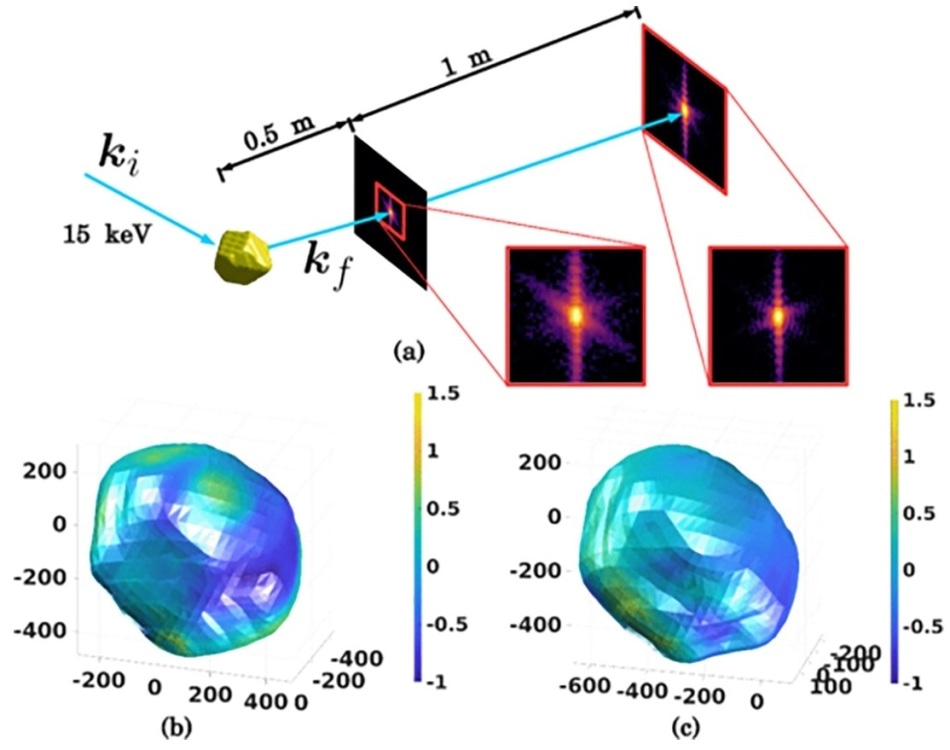Jul 19 2019
Proper tools enable researchers to have Superman-like X-ray vision that uncovers obscure features buried within objects—but it is highly difficult.
 This schematic (top) shows Bragg coherent diffraction imaging phase retrieval of X-rays scattered by a gold nanoparticle. Two reconstructions of the gold nanoparticle are shown at the bottom. (Image credit: Argonne National Laboratory)
This schematic (top) shows Bragg coherent diffraction imaging phase retrieval of X-rays scattered by a gold nanoparticle. Two reconstructions of the gold nanoparticle are shown at the bottom. (Image credit: Argonne National Laboratory)
The Advanced Photon Source (APS), an Office of Science User Facility at the U.S. Department of Energy’s (DOE) Argonne National Laboratory, offers researchers access to highly penetrating X-rays with the potential to light up—at the atomic level—materials buried deep within other structures.
The next phase for the APS—the APS Upgrade—changes current APS into a world-leading, storage-ring-based, high-energy X-ray light source that arms researchers with a considerably more robust tool for examining and enhancing the materials and chemical processes that influence almost every aspect of people’s lives.
Specifically, the Upgrade allows the use of lensless imaging techniques with high-energy X-rays to overcome optics drawbacks for acquiring the highest spatial resolution deep within opaque samples.
However, the use of high-energy X-rays for deep penetration comes with a possible problem—deeply penetrating X-rays can suffer drawbacks with existing detector technology.
Essentially, the signal on the detector gets more and more compressed as we go to higher and higher X-ray energies. The price we pay for more penetrating X-rays is a loss of fidelity in the recorded data.
Siddharth Maddali, Postdoctoral Researcher, Argonne National Laboratory
As part of a new study, scientists at Argonne have discovered a new method to overcome these drawbacks.
Argonne X-ray physicist Stefan Vogt states that these drawbacks are like using a low-resolution computer monitor to see a high-resolution digital photograph. “You cannot see the fidelity of the original image,” he said.
Due to the overall effect, the image appears to be pixelated, said Maddali, one of the authors of the study.
Since the distance between target and detector is rather preset, enhancing the resolution of a pixelated X-ray scattering image—basically, sharpening it—needs computational algorithms that form subdivided “virtual pixels” that can redistribute the pixelated image.
After that, scientists can employ a process known as phase retrieval to reconstitute real-space information about the sample on the basis of the scattered X-ray wavefronts.
It’s similar to trying to determine the shape and size of a stone thrown into a pond by looking at the ripples the stone creates, except in three dimensions. If your pixel size is small enough so that you can see the ups and downs in the wave, you can computationally process those images and obtain a three-dimensional picture of the object causing the scattering.
Siddharth Maddali, Postdoctoral Researcher, Argonne National Laboratory
Using signal processing in this way enables researchers to effectively and computationally correct an image that would have otherwise needed an experimentally impossible system of lenses to resolve.
Researchers could employ this method to acquire better information related to material interfaces, and thus better understand and eventually control the behavior of new materials.
A paper based on the research, titled “Phase retrieval for Bragg coherent diffraction imaging at high X-ray energies,” was published in the May 2019 edition of Physical Review A. Other Argonne authors included Wonsuk Cha, Ross Harder, Jun-Sang Park, Peter Kenesei, Jonathan Almer, Youssef Nashed, and Stephan Hruszkewycz. Marc Allain from Aix Marseille University also partnered.
The study was funded by DOE’s Office of Science.